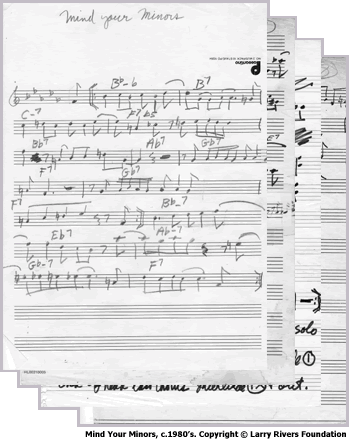

Larry Rivers Jazz
By Howard Brofsky
Larry Rivers had a deep and powerful connection with music. It touched and identified him in a way nothing else could. In his autobiography “What Did I Do?“, he wrote: “I knew that being in the presence of art, making art -- even making love -- couldn’t get at the feelings I felt when I played music.” By age seventeen, he was already leading his own band under his birth name Yitzak Grossberg. On one fateful night an emcee introduced his group as “Larry Rivers and his Mudcats” and the name stuck. After a brief stint in the army, Rivers pursued his passion and enrolled on the GI Bill at the Juilliard School of Music, where 19-year-old Miles Davis was a classmate. Switching between clarinet, tenor sax and baritone sax, Larry soon joined several second-rank big bands on his baritone and traveled the country.
I met Larry around 1949 at a jam session at the Open Door, a place in Greenwich Village where Charlie Parker used to sit in. Twenty-five years flew by before we would meet again -- and once more, jazz was the matchmaker. David Levy, then the Dean of Parsons, and a saxophonist, organized a group to rehearse at Larry’s loft. It was a unique combo: Larry, then playing tenor sax, Levy on alto, the painter Howard Kanovitz (a long-time friend of Larry’s) on trombone. I was on trumpet, emerging from many years as a musicologist-professor specializing in18th century Italian music, Myron Schwartzman (a Joyce scholar-professor) played piano and Charlie Toor (a printer) was on bass. We couldn’t find a satisfactory artist/professor on drums, so we enlisted a professional jazz drummer, Earl Williams. We called ourselves the East Thirteenth Street Band in honor of the street where Larry lived and worked and where we played on a bandstand -- complete with grand piano, drum set and amplifier for bass or singers -- which was built in the middle of his sprawling block-long loft.
After several years, dozens of performances, and a recording with chanteuse Phoebe Legere who often accompanied the band, Larry decided it was time for a smaller, more flexible ensemble, with younger musicians. We formed the Climax Band (of course the name was coined by Larry) with Pete Calandra on piano, Stomu Takeishi on electric bass, Earl Williams on drums, and Larry and I in the front line. To continue the tradition of the “chick singer” (as Larry politically incorrectly described it), his daughter Gwynne sometimes took that role.
We both wrote original music -- but Larry’s music was unabashedly original, fearless, quirky and masterful. He owed a debt to Thelonious Monk, whom he used to see at the Five Spot café; many of his pieces referenced Monk in their titles, such as Monk’s Whole (using the whole-tone scale) and A Monk in the Country. Larry took his composing seriously and he often phoned with musical questions, whether it was a problem of notation or harmonic progression. He was fired up about the Climax Band, always ready to play, and try out new material. We gigged as often as we could in clubs in New York City and private parties in the Hamptons.
Larry’s commitment to music never wavered. Whenever he was invited to lecture or show art, he always insisted that one of the bands accompany him as part of his presentation. At his raucous parties, the band was a constant fixture and Larry, who had something of the unkosher ham in him, would play and -- sing. When he belted out Brother Can You Spare a Dime? or Boulevard of Broken Dreams, his interpretation was humorous and strangely plaintive.
Like Rivers the man, there was nothing half-hearted about his approach to music, jazz in particular. He was courageous and wholly original -- and it was an honor to play alongside him.
Howard Brofsky









